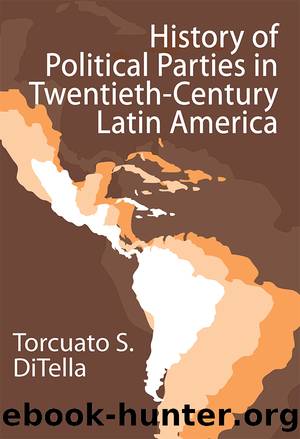History of Political Parties in Twentieth-Century Latin America by Torcuato S. Di Tella

Author:Torcuato S. Di Tella [Tella, Torcuato S. Di]
Language: eng
Format: epub
Tags: Political Parties, Political Science, Political Process
ISBN: 9781351515498
Google: iisxDwAAQBAJ
Goodreads: 36079112
Publisher: Routledge
Published: 2003-05-01T00:00:00+00:00
The End of the Uruguayan Switzerland
In Uruguay, the Colegiado system ended in 1966, killed by a referendum in which the majority, now composed of both Blanco and Colorado sectors, decided to return to classical presidentialism. In the ensuing elections, the executive post was obtained by General Oscar Gestido, an independent Colorado, who had as his running mate the traditionalist Jorge Pacheco Areco. Gestido, a sort of Uruguayan Eisenhower, very soon died in office, leaving the vice president in charge but without much legitimacy. Pacheco had been trying to cultivate a strongman profile, and he continued along those lines, with a considerable response among some popular sectors.
The economic crisis, largely fueled by a catastrophic fall in wool prices, was beginning to erode the prosperity and the social services the country had become accustomed to. The Cuban model was, at the same time, seen as a realistic alternative for intellectual elites and university students. Frustration in Uruguay, as in Argentina, was particularly intense among them, because those two countries had the highest standard of living in the region, with the corresponding institutional and cultural development, and a more complex division of labor and availability of modern career patterns. When the prospects offered by this situation began to falter, frustration was particularly intense, and a general feeling of decrease in the international standing of the two countries stimulated a search for radical substitutes among the youth, often at the upper-middle class level.
Thus a propitious breeding ground was created for urban guerrillas or radical sympathizers, in Uruguayâs case forming the Tupamaro organization (very active from 1968 to 1972), along Marxist lines, as there was no equivalent of a Peronist movement, and nationalism never had caught on. There was thus no connection to a massive popular movement, as in the Argentine case. The founder of the Tupamaros (a name harking back to Tupac Amaruâs times) was Raúl Sendic, who had started as an organizer of strikes and agrarian protests in the northern sugar area. The underground Tupamaros had as their surface organization a Movimiento 26 de Marzo, or M-26. Repression was much easier than in Argentina, due to the above-mentioned lack of connections to a preexisting popular party.16
Pachecoâs successor was Juan Maria Bordaberry, a Colorado of ruralista origins in Nardoneâs (âChicotazoâ) current. The Colorado Party won the election (1971) by a small margin over the Blancos, who had spawned a moderate but significant left under the leadership of Wilson Ferreira Aldunate, in what became one of the main factions of the lema. On the independent Left a very broad coalition was formed, the Frente Amplio, including the Communists, the Socialists (very much radicalized since in 1961; the younger elements had defeated the old leadership of moderates such as Emilio Frugoni), and the Christian Democrats, who also had split from an older organization. In the Frente Amplio, dissident factions of the Colorados and Blancos were also included, as well as more radicalized and pro-guerrilla groups. In total, they got 18 percent of the popular vote, a remarkable increase over their traditionally modest levels.
Download
This site does not store any files on its server. We only index and link to content provided by other sites. Please contact the content providers to delete copyright contents if any and email us, we'll remove relevant links or contents immediately.
The Secret History by Donna Tartt(18862)
The Social Justice Warrior Handbook by Lisa De Pasquale(12143)
Thirteen Reasons Why by Jay Asher(8801)
This Is How You Lose Her by Junot Diaz(6803)
Weapons of Math Destruction by Cathy O'Neil(6152)
Zero to One by Peter Thiel(5693)
Beartown by Fredrik Backman(5609)
The Myth of the Strong Leader by Archie Brown(5429)
The Fire Next Time by James Baldwin(5253)
How Democracies Die by Steven Levitsky & Daniel Ziblatt(5134)
Promise Me, Dad by Joe Biden(5090)
Stone's Rules by Roger Stone(5029)
A Higher Loyalty: Truth, Lies, and Leadership by James Comey(4851)
100 Deadly Skills by Clint Emerson(4845)
Rise and Kill First by Ronen Bergman(4706)
Secrecy World by Jake Bernstein(4653)
The David Icke Guide to the Global Conspiracy (and how to end it) by David Icke(4629)
The Farm by Tom Rob Smith(4442)
The Doomsday Machine by Daniel Ellsberg(4420)
